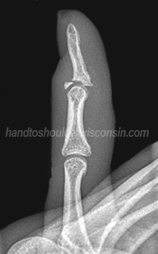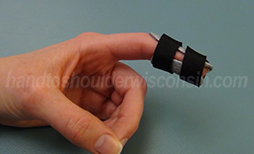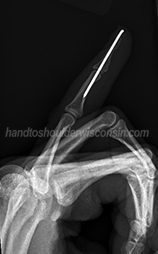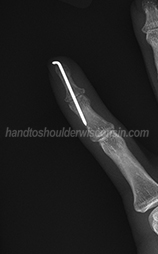At Hand to Shoulder Center of Wisconsin, our orthopedic doctors have extensive experience in the treatment of mallet fingers. Contact our team of orthopedic specialists at Hand to Shoulder Center in Appleton or Green Bay to get mallet finger treatment today.
What is Mallet Finger?

Figure 1: Mallet fracture with bone fragment
Mallet finger also referred to as baseball finger occurs when an incident causes the extensor tendon at the tip of the finger or thumb to be stretched, cut or ruptured. The injury can involve the tendon alone, or occur with a fracture at the tendon-joint interface (Fig. 1).
Mallet Finger Symptoms and Causes
Fingers are made up of 14 small bones called phalanges (singular form: phalanx). Phalanges are formed by three components; the proximal phalanx (closest to the knuckle), middle phalanx and the distal phalanx (tip of the finger). Symptoms of mallet finger includes pain, swelling, possible bruising, and an inability to actively elevate the end joint of a digit.
Normally, the phalanges are aligned precisely for ease of movement such as gripping, grasping, and manipulating small objects. When one or more of the phalanges are damaged, it can cause your entire hand to be out of alignment, causing pain, stiffness, and loss of movement. The most common mallet finger symptom is a drooping or dropped finger at the end joint. Without treatment, a mallet finger can cause prolonged stiffness, deformity, pain, and decreased function.
Mallet finger can occur from the simplest of tasks, such as tucking in bed sheets, or scrubbing a carpet, however, the most common occurrence is from a forceful blow to the fingertip or hitting it against a solid object (such as trying to catch a ball).
Diagnosis and Mallet Finger Treatment
The sub-specialty trained orthopedic physicians at Hand to Shoulder Center of Wisconsin are highly experienced in all hand and upper extremity injuries and conditions. An initial examination is conducted on all hand injuries. The evaluation will consist of a visual examination of the fingers along with range of motion of the fingers. X-rays are done to determine if a fracture has occurred.
Depending on the severity of the injury, treating mallet finger typically does not include surgery; however, in some unique cases mallet finger surgery is required.

Figure 2: Custom-designed mallet finger splint
In non-surgical cases, mallet finger treatment typically includes, icing for the first few days to reduce swelling and tenderness, and over the counter pain medication. The most important part of conservative treatment is use of a mallet finger splint. The splint can be pre-fabricated or custom-designed by a licensed occupational or physical therapist. It is worn continuously for approximately 6-8 weeks (Fig. 2). The splint is designed to support the end joint in full extension, allowing the damaged tendon to reconnect and heal. If the splint is removed and the tendon healing is disturbed, the 6-8 week splint-wearing process may need to restart.

Figure 3: Mallet finger pin
Once the splint is worn for the 6-8 week duration, it is removed and rehabilitation exercises may be ordered by your surgeon. An occupational or physical therapist may work closely with you to restore motion and improve the strength of your injured finger.

Figure 4: Mallet finger pin – side view
In more complex injuries that include a significant fracture, surgery for your mallet finger may be warranted. This often involves the surgeon placing a pin through the fractured bone and end joint of the finger (Fig. 3-4). A splint is also worn to protect the surgically treated digit. Depending on the rate of healing, the pins may be needed for 4-6 weeks.
Surgery can be performed under local anesthetic and is performed as an outpatient surgery. Surgery locations include, Woodland Surgery Center or one of the three Fox Valley hospital locations.
Usual outcomes with a typical mallet finger are very good with return to full activities common.
